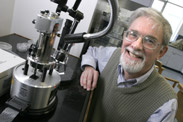Pulp fact
It may be simply a bunch of sugar molecules strung together in a linear chain, but cellulose is important. Suck all the cellulose out of Canada's forests, and the trees would flop over and mulch together like so much lichen. "It's the molecule that makes plants stand up," says chemistry professor Derek Gray. "And Canada probably has the richest cellulose resources in the world." But this cellulose stockpile doesn't just keep the trees upright — it is also critical for the national economy. "You can't make paper without cellulose," says Gray. "And the pulp and paper industry is one of main reasons Canada has a positive trade balance."

Chemistry professor Derek Gray
This importance has not gone unnoticed, and on December 15 the Natural Sciences and Engineering Research Council (NSERC) announced $1.5 million funding for two NSERC Industrial Research Chairs in McGill's Department of Chemistry; the industrial partner, Paprican (the Pulp and Paper Research Institute of Canada) will provide another $1.5 million, as well as resources in kind, to support research over the next five years. Theo van de Ven, who also serves as director of McGill's Pulp and Paper Research Centre, was awarded the Paprican/NSERC Industrial Research Chair in Colloid and Papermaking Chemistry, while Gray is the new Paprican/NSERC Industrial Research Chair in Cellulose Properties and Utilization. The two new chairs are also expected to provide support — and a research focus — for approximately 20 graduate students.
The Industrial Research Chairs are a logical way for Paprican to carry out its mandate. Eighty years ago, the Quebec pulp and paper industry endowed a McGill Professorship in Cellulose and Industrial Chemistry; within three years, the Canadian government had also become involved, and Paprican was created. "Today, the Canadian pulp and paper industry faces rising costs and global competition," says David MacDonald, Paprican's vice-president of research and education. "We need industry, universities and research institutes to work as a team."
The knowledge the chairs generate should help keep the Canadian industry at the front of the field. Professor van de Ven's research explores the colloidal chemistry characterizing the "wet" stage of the papermaking process. Colloids are molecules suspended in another substance: think of the viscous muck of wet-end papermaking. "We want to find ways of using new knowledge about colloidal phenomena to improve both process and products," says van de Ven. Such research could result in a finished product with a firmer bond, and could also ensure greater recycling successes.
Colloidal chemistry is closely linked to cellulose research when it comes to top-notch papermaking. "The strength of a paper sheet depends upon the strong bond forming between fibres when water evaporates, and so far it is very mysterious what goes on at the molecular level," says Gray. "But nanotechnology tools enable us to look at these fibres. We can hope to modify and change properties to optimize bonding, which is key to creating strong fibres and also to recycling them." Gray's research seeks to characterize the surface morphology of the fibres so that we know how to ensure the strength of the bonds. In addition, cellulose-reinforcing fibres can be used with other materials and products; for instance, they can be implanted in weaker materials that are environmentally and economically preferable, thus strengthening those materials. Such a process makes efficient use of Canada's fibre resources. Nanocrystal suspensions, the other focus of Gray's research, also offer the possibility of composites to strengthen other materials. They can also be used in applications like iridescent coatings (such as the sheen on the new $20 bill) useful for sensors and security systems.
At the award ceremony, Gray stressed the symbiotic nature of academic research and industry applications exemplified by the Industrial Research Chair program, noting, "Curiosity-motivated research led to the discoveries on which our chair proposals were based." And as the chairs will also support a solid crew of graduate students, they will feed the curiosity of a new generation of researchers.
